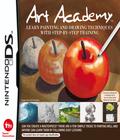The Nintendo DS has become the most popular handheld gaming console to be wielded by non-gamers. It is perhaps no surprise that these audiences have included non-gamers attracted to unusual non-games, such as Korg DS-10. For a while, Nintendo has provided a few such utilities for the DSi on its Shop Channel. More recently, it has worked with Headstrong Games to produce two entries in the Art Academy series: tools meant to teach basic art principles to their users. Nintendo decided to give the two games a combined (and expanded) release as a cartridge. While those who have enjoyed the DSi Shop version won't find much new material here, those who are interested in exploring their creative side may find Art Academy to be an unexpected treasure.
Art Academy's core is found in its Free Paint mode, where users paint drawings with no guides or limits, using a surprisingly effective set of utilities that are centered around two basic tools: pencils and paintbrushes. The goal is to accurately simulate a miniature canvas, and both tools are robust enough to provide for this simulation. Pencils let you choose between 2H, HB and 2B leads (and an eraser), and whether you draw with the point or the side (useful for shading). Paints include six brushes and a fully simulated palette, using 10 basic oil-based paints to let you mix any desired color. The combination, while basic, provides as many tools as many real artists use, and it intentionally and meticulously tries to represent the real thing as closely as possible.
These tools are supplemented by a few assisting features. No feature automates the basics, but they can all potentially help out. You can throw images (provided samples or your previous paintings) on the top screen and adjust it through a series of graphical filters. There are also some handy zoom functions, a basic six-by-eight grid, and a color wheel for the paint manipulation menu. On a DSi, you can also take photos and load them as references. The tools are (intentionally) hampered by a limitation: Once you open the paint menu, you can't use the pencils anymore. While this is realistic for working with oil paints, it is also highly annoying. (A "lightbox" functionality would have been very desirable but is not provided.)
The program's "meat," such as it were, is provided by a series of 10 lessons, each centering on a different drawing. Even the first two tutorial lessons have you painting basic scenes and working with simple forms of basic art principles, including chiaroscuro shading, the concept of warm/cool colors, and other essentials. These are guided by a narrator, Vince, who shows techniques, one by one, walks the user through setup phases and then, surprisingly, leaves the player entirely to his own devices in implementation. The game makes no judgment whatsoever on the player's art, and Vince does not even implicitly congratulate success. This may seem disconcerting to many players, but it was for the best. Attempting to judge art computationally remains in the realms of complete and utter madness for good reason, and Nintendo cannot work that much magic.
These lessons focus strongly on drawing scenes of nature and natural objects, to provide for artistic flexibility and allow the player to produce strong-feeling results on the DS' limited screen. A lesson is comprised of a series of steps. Usually, Vince does a video recording of one thing and then has you match that step before going to the next. He intentionally repeats steps that you may feel you already know in order to build up muscle memory, and he often intentionally leaves things that you can observe. The most obvious example is a strong, and realistic, emphasis on avoiding long strokes when penciling or painting and favor shorter, quicker moves instead.
The biggest question is whether these lessons, fundamentally, work. The answer to this varies on your definition, but in terms of teaching one how to draw, it is as good at the task as any book or video — perhaps better, due to its regimented steps. By the time I had finished four lessons, I found that my hand was steadier (handy side effect: improved scores on Trauma Center) and that I had a better understanding of basic artistic techniques. Art Academy intentionally stops short of teaching anything about human figure drawing — presumably because the level of detail would run beyond the DS system limitations. Those who wish to get to that level will need to find other sources — though Art Academy builds up a solid foundation.
Fundamentally, Art Academy isn't a game. You are not rated for your actions in any way, shape or form, as one would expect from a game. You are simply provided a toolbox, a series of videos and text clips, and you let loose and learn how to express your imagination. The results will impress many, and for those seeking to learn basic art cheaply, Art Academy is a good recommendation. However, there is no significant new content for those who have enjoyed the game on the DSi Shop Channel, and its limits won't impress users of high-end paint software — though it's neat that you can paint this well on a portable gaming device. (Nintendo, this needs to be expanded into Mario Paint DS.)
Score: 8.0/10
More articles about Art Academy










 Art Academy is a portable art course, providing everyone from beginners to experts with tools to create their own works of art plus simple tutorials to learn about color, shading, movement and perspective.
Art Academy is a portable art course, providing everyone from beginners to experts with tools to create their own works of art plus simple tutorials to learn about color, shading, movement and perspective.

























